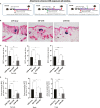Chemopreventive efficacy of silibinin against basal cell carcinoma growth and progression in UVB-irradiated Ptch+/- mice
- PMID: 35184170
- PMCID: PMC9234765
- DOI: 10.1093/carcin/bgac023
Chemopreventive efficacy of silibinin against basal cell carcinoma growth and progression in UVB-irradiated Ptch+/- mice
Abstract
The factors (environmental and genetic) contributing to basal cell carcinoma (BCC) pathogenesis are well-established; however, effective agents for BCC prevention are marred by toxic side-effects. Herein, we assessed the efficacy of flavonolignan silibinin against ultraviolet B (UVB)-induced BCC in Ptch+/- (heterozygous patched homolog 1 gene) mouse model. Both male and female Ptch+/- mice were irradiated with a 240 mJ/cm2 UVB dose 3 times/week for 26 or 46 weeks, with or without topical application of silibinin (9 mg/200 µl in acetone, applied 30 min before or after UVB exposure). Results indicated that silibinin application either pre- or post-UVB exposure for 26 weeks significantly decreased the number of BCC lesions by 65% and 39% (P < 0.001 for both) and the area covered by BCCs (72% and 45%, P < 0.001 for both), respectively, compared to UVB alone. Furthermore, continuous UVB exposure for 46 weeks increased the BCC lesion number and the BCC area covered by ~6 and ~3.4 folds (P < 0.001), respectively. Notably, even in this 46 week prolonged UVB exposure, silibinin (irrespective of pre- or post-UVB treatment) significantly halted the growth of BCCs by 81-94% (P < 0.001) as well as other epidermal lesions; specifically, silibinin treated tissues had less epidermal dysplasia, fibrosarcoma, and squamous cell carcinoma. Immunohistochemistry and immunofluorescence studies revealed that silibinin significantly decreased basal cell proliferation (Ki-67) and the expression of cytokeratins (14 and 15), and Hedgehog signaling mediators Smo and Gli1 in the BCC lesions. Together, our findings demonstrate strong potential of silibinin to be efficacious in preventing the growth and progression of UVB-induced BCC.
© The Author(s) 2022. Published by Oxford University Press. All rights reserved. For Permissions, please email: journals.permissions@oup.com.
Figures







References
-
- Boehnke, K., et al. . (2012) Stem cells of the human epidermis and their niche: composition and function in epidermal regeneration and carcinogenesis. Carcinogenesis, 33, 1247–1258. - PubMed
Publication types
MeSH terms
Substances
Grants and funding
LinkOut - more resources
Full Text Sources
Medical
Molecular Biology Databases
Miscellaneous

